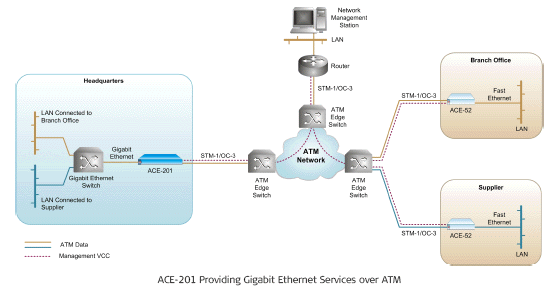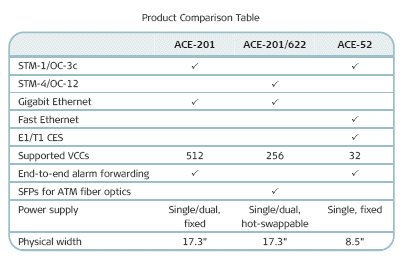




ACE-201 Multiservice Network Termination unit from RAD
ACE-201 is a Customer Located Equipment (CLE) dedicated for provisioning interworking services of Gigabit Ethernet over ATM networks. Used as a Network Termination Unit (NTU), the RAD ACE-201 provides a demarcation point between the provider’s network and the customer premises. This enables end-to-end traffic and network management control.

ACE-201 ATM CAPABILITIES
Using the RAD ACE-201, service providers can assign each virtual connection (VC) to different service classes, define the QoS parameters and shape the ATM egress traffic accordingly. By limiting the port ATM egress rate, service providers can control the total bandwidth provided to their users.
ACE-201 allows up to 512 virtual circuit connections (VCCs) to be established and used simultaneously over an ATM network.
The following service classes are supported: CBR, VBR, GFR, UBR and UBR+. On the ATM egress, ACE-201 provides two levels of traffic management:
Shaping per VC
Rate limiting of the ATM port's outbound traffic.
ACE-201 maps QoS parameters according to the VLAN priority or ToS field. QoS is supported in two modes:
Mapping to different VCCs (with different traffic descriptors) of the same bridge port according to configured priority
Mapping to four strict-priority VCC queues according to configuration.
The ATM timing reference for outbound (TX) traffic is based on an internal oscillator or on inbound traffic in loopback timing mode.
ATM OAM functionality supported by ACE-201 reduces operational costs by providing end-to-end traffic manageability and fault localization. OAM functionality complies with ITU-T I.610 and includes:
AIS/RDI – system indication for local or remote fault conditions. In case these indications are detected in the network interface, ACE-201 sends a trap to alert the management system, and responds accordingly (RDI upon AIS reception)
Continuity Check (CC) – used for checking service availability. ACE-201 sends a CC cell periodically over a predefined VCC to verify that the link is functional.
Loopback (LB) – used for fault localization. LB cells are sent with a
destination address to be looped at any network element that was preassigned with loopback point address.
The RAD ACE-201 also loops back received LB cells. Roundtrip delay measurements based on loopback cells are also supported.

ACE-201 GIGABIT ETHERNET CAPABILITIES
ACE-201 supports VLAN-aware bridging with full VLAN ID range (1 to 4094). Up to 512 VLANs can be defined. To allow special traffic formats, including ISL and stacked VLANs, the Ethernet frame can include up to 1594 bytes.
The supported frame types are: untagged, priority-tagged and VLAN-tagged.
ACE-201 provides L2 VPN services. Total traffic separation between customers is achieved by assigning VLAN IDs to virtual connections (VCs). Optionally, different priority levels can be defined within each VPN by mapping VLAN priorities to different VCs with appropriate QoS parameters.
ACE-201 ACDSDH/SONET CAPABILITIES
The unit's SDH/SONET network interface (fiber optic) supports STM-1/OC-3C framing for traffic speeds of up to 155 Mbps.
Physical layer statistics are provided for the SDH/SONET interface, along with comprehensive diagnostics, alarm
generation and alarm forwarding capabilities.
ACE-201 SLA DIFFERENTIATION
Using ACE-201, service providers can offer SLA (Service Level Agreement) differentiated services to generate revenues from their existing ATM infrastructure. In order to guarantee the SLA, it is important to maintain end-to-end control over the QoS.
By defining and monitoring traffic management parameters from the
customer’s premises, carriers gain the following advantages:
Users cannot over-utilize the allocated bandwidth
Statistical efficiency of the link while using the same backbone equipment
Complete information on service performance. Access to this information can optionally be opened to users
Proactive readiness for changes required on the network, before services run into problems.
ACE-201 ALARM FORWARDING
ACE-201 supports bidirectional alarm forwarding. If enabled, an alarm detected at either the SDH/SONET or ATM level disables the unit's Ethernet port. ACE-201 then sends an SDH/SONET alarm or ATM OAM cells towards the ATM network, to notify the remote end about the local Ethernet link disabling.
ACE-201 MANAGEMENT
For comprehensive configuration, monitoring and diagnostics, ACE-201 can be managed:
Locally, by connecting an ASCII terminal to the unit's RS-232 port
Remotely, over the ATM network using a dedicated VC
Inband, via the Gigabit Ethernet port
Over a bridge, via the unit's bridge VCCs connection.
The RADview-EMS network management application monitors, configures, isolates faults and presents network statistics using a graphical, user-friendly display. This PC or Unix-based application alerts in
real-time on service availability and faulty network conditions. Software upgrade and configuration files can be remotely downloaded or uploaded to ACE-201 via TFTP or XMODEM.
ACE-201 PLUG-AND-PLAY
The ACE-201 plug-and-play feature enables device installation without any pre-configuration or on-site setup to minimize truck-roll. When plugged into the network, ACE-201 automatically learns both its own (host) and the NMS (manager) IP addresses. A required configuration is then downloaded to the device from a remote site.

ACE-201 product data sheet (pdf)